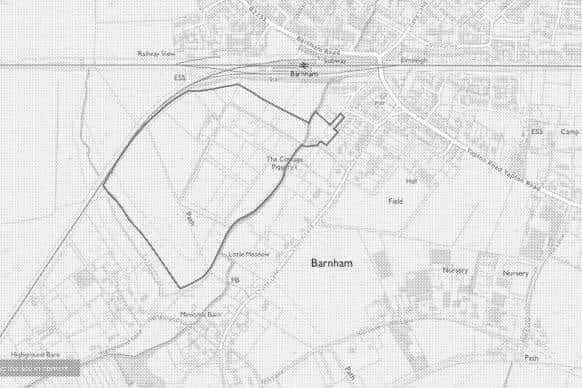This is why 200-home Barnham development has been allowed at appeal
and live on Freeview channel 276
Gleeson Strategic Land’s application to build 200 homes west of Church Lane with access from Marshall Close was refused by Arun District Council in February 2021.
Planning officers argued the scale of development would be inappropriate for the location and cause significant harm to the character and appearance of the area.


Advertisement
Hide AdAdvertisement
Hide AdBut the developer appealed against the decision and a planning inspector has ruled in its favour following an appeal.
In his decision report, inspector David Spencer noted the ‘challenging circumstances’ around housing delivery and a ‘lack of a clear prospect that there will be a plan-led solution in Arun in the short term’.
Although highlighting the site would be outside the village’s built up area boundary and is not allocated in the emerging Barnham and Eastergate Neighbourhood Plan ‘on the cusp’ of being made, Arun is well short of being able to demonstrate a five-year housing land supply.
He added: “Barnham is clearly one of the more sustainable locations in inland Arun. The appeal site is relatively contained and would provide a reasonably logical consolidation of development in this part of Barnham including with the adjoining BEW [Barnham, Eastergate and Westergate allocations].”
Advertisement
Hide AdAdvertisement
Hide AdArun needs to identify land for 10,079 homes over the next five years, but delivery since 2011 has averaged just 609 dwellings per annum.
Mr Spencer noted from Church Lane the appeal proposal would result in a ‘perceptible loss of characteristic countryside and introduce a new urban edge’, but suggested the adverse landscape impact and visual effects would be ‘localised and limited’.
The character and appearance of Marshall Close would also be ‘harmfully affected’ but he did no find any harm to heritage significance of listed buildings or unacceptable harm to non-designated heritage assets. He also found less than substantial harm to the heritage significance of the Barnham Church Lane Conservation Area.
He did not consider the absence of a direct link from the site to the railway station to be harmful and was satisfied about a reasonable prospect of securing necessary rail safety improvements to the unmanned level crossings.
Advertisement
Hide AdAdvertisement
Hide AdThe inspector was also satisfied conditions would mean the site would be appropriately connected to the BEW development and an alternative safe route for pedestrians, and potentially cyclists, into the centre of Barnham.
On road safety, Mr Spencer was also satisfied that improvements proposed within Marshall Close would mean the public highway could safely accommodate the number of extra vehicles likely to be generated by the new homes.
When it comes to flooding, he noted the proposed housing would not be situated within areas of higher flood risk associated with Barnham Rife, and the development would provide measures to mitigate surface water run-off at a better rate than the existing unmanaged run-off.
He also had sufficient evidence that modest extra foul water flows could be adequately catered for without increasing the risk of related flooding elsewhere.
Advertisement
Hide AdAdvertisement
Hide AdThe appeal proposal would also make provision for affordable housing and other infrastructure, he concluded.
The inspector made a partial award of costs against the council as it had failed to provide sufficient evidence to substantiate a reason for refusal on foul water grounds, while the appeal had needed to address ‘vague and generalised assertions’ about the proposal’s impact on the setting of listed buildings.
